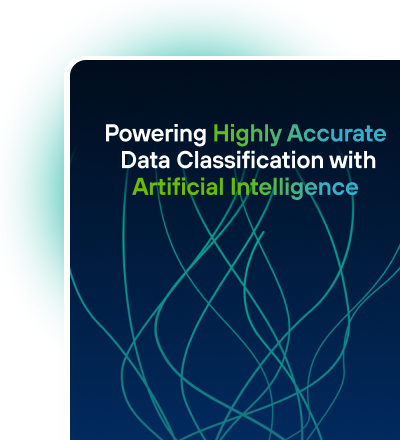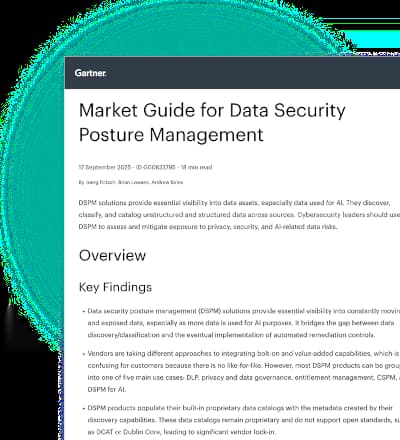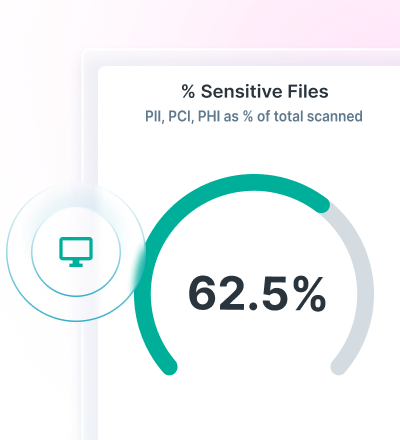12,000 多名客户不會錯










































以閃電般的速度尋找整個企業的資料並編目。


Gartner®: Market Guide for Data Security Posture Management
In their first analysis of the new DSPM security category, Gartner® identifies the five main use cases, breaks down DSPM features and explores the requirements for securing GenAI.
為什麼選擇 Forcepoint Data Classification?
跨多個來源的資料進行分類,並使用 AI Mesh 持續提高準確性和效率,為組織節省寶貴的時間與資源。
覆蓋業界最廣泛的資料類型,有助於簡化合規,同時為組織資料提供更好的保護。
AI Mesh 在毫秒內快速準確地對資料進行分類,簡化流程,減少人工工作,讓團隊能夠專注於更高價值的任務或更重大的事件。
利用開箱即用的關鍵法規和業界最廣泛的資料類型覆蓋,避免昂貴的不合規罰款。

利用 Forcepoint 確保任何地方的資料安全。
利用我們的資料安全解決方案,防止入侵、簡化合規、統一政策管理,並即時適應風險。
Forcepoint DLP:利用 DLP 軟體即服務 (SaaS),保護敏感資訊,並強制執行合規性。
DSPM(資料安全態勢管理):自動化資料發現、分類與協調,讓整個企業的資料獲得完全控制與可見性。
Risk-Adaptive Protection:根據用戶行為 / 使用者行為自動調整政策,即時適應新興風險。
常見問題
什麼是Data Classification?
Data Classification 是將資料標記並組織成預定義類別的做法,讓定位與檢索變得更加容易,同時確保授權使用者的安全存取。
為什麼Data Classification對組織很重要?
Data Classification做法對於維持強大的安全態勢是必要的。通過確保安全團隊知道在哪裡尋找敏感資訊,並制定允許誰存取資訊的規則,您可以預防或遏制資料入侵,讓未經授權的使用者遠離他們不應該擁有的資源。
Data Classification的類型有哪些?
基於內容的分類:這是檢查文件並在其中搜尋敏感資訊的做法。 如果問題在於不適合公眾使用的資訊隱藏在看似無害的文件類型中,這會有所幫助。
基於情境的分類:這種方法不會直接檢查文件內容,而是主要查看與文件關聯的元資料,尋找指示內部資料敏感的線索。 這可能包括識別檔案的儲存位置、哪位使用者創建檔案,或檔案針對哪個應用程式。 當使用者基礎經過良好訓練,並且已經對敏感資料擁有一定程度的控制時,這種方法效果良好。基於使用
者的分類:這會讓使用者承擔梳理檔案並對其進行分類的負擔。 雖然這種方法在最佳情況下可以顯著減少誤報,但它不僅依賴於訓練有素的使用者基礎,還依賴於手動分類資料的時間。 這意味着它通常只適合更精簡的組織或較小的資料集。
實施 Data Classification 的最佳做法是什麼?
身份識別:尋找敏感資料的所在位置,包括雲端儲存庫與實體硬碟,並立即採取任何必要的步驟,透過加密、物理存取控制等方式確保資料安全。
組織:提出將使用的流程,將資料組織成類別。
培訓:授權員工發揮作用,根據類別為資料加上標籤,並將其放置在適當的位置。 在此過程中扮演角色的人越多,培訓就越需要嚴格,確保人為錯誤不會影響您的工作。
合規性:瞭解適用於營運的資料安全和資料隱私法規,以及不合規的處罰。
解決方案:尋找最適合組織的Data Classification解決方案。在許多情況下,最好的做法是使用能協助資料發現、分類及排定優先順序的全面資料安全平台,而不是將不同供應商的解決方案拼湊在一起。
Data Classification 能否有助於符合法規要求?
是的,Forcepoint Data Classification 可幫助簡化 80 多個地區的合規性。它通過開箱即用的關鍵法規和業界最廣泛的資料類型覆蓋,幫助您避免昂貴的不合規罰款。
Forcepoint Data Classification 的準確程度如何?
Forcepoint Data Classification 利用人工智能驅動的精確度與效率。它利用 AI Mesh 技術,協助對多個來源的資料進行分類,不斷提高準確性和效率,為組織節省寶貴的時間與資源。
什麼是 AI Mesh,如何使用?
Forcepoint Data Classification 利用 AI Mesh,提供高度準確的 Data Classification。其網路人工智慧架構依賴於小型語言模型和先進的人工智慧元件,以提高效率,減少誤報。











